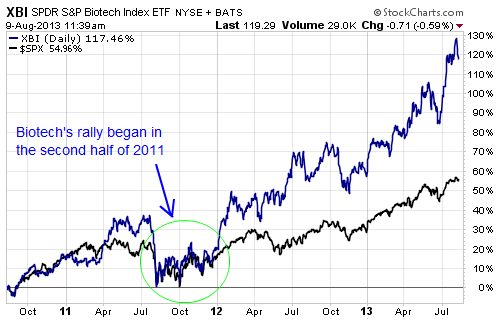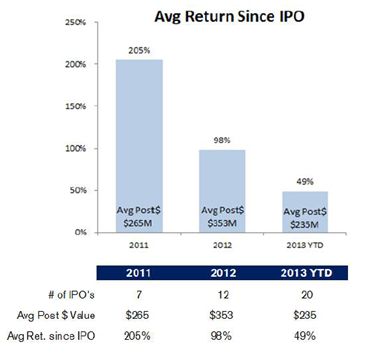It’s tough to beat the market when stocks are soaring.
But one sector is doing just this, delivering nearly 2-times the gains of the broad market in 2013. It’s not housing, financials or even energy, even though all of these sectors are thriving.
It’s the biotech sector and the business of drug development. The benchmark S&P 500 biotech sector ETF (NYSE:XBI) is up an incredible 36% year to date, handily outperforming the 19% rise for the S&P 500.
That performance puts biotech stocks well ahead of all other sector this year. While the Health Care (NYSE:XLV) and Financials (NYSE:XLF) sectors are also rallying, they are trailing biotech by 8% to 10%.
Biotech’s historic run to the top of the market is even more impressive considering that it has endured for more than 24 months. The biotech bull-run began in August 2011, and has barely taken a breather.

Why the big move? The reasons are extremely attractive valuations and the defensive attributes of health care and pharmaceutical industry. At the beginning of this year the biotech sector was still trading at a discount with a forward PE of only 10-times 2015 estimated earnings.
Another contributing factor is the massive gains for biotech IPOs. In other words, it’s been hard to lose money in this high growth sector. And that’s despite the considerable risks associated with investing in early-state biotechnology companies.

So has the biotech rally run its course? Are there more gains ahead? Or is this high-flying sector ripe for a correction?
There is still money to be made in biotech, but my advice is that investors look past mutual funds and ETFs and instead invest in individual companies. This is how you’ll capture the greatest amount of upside.
Based on 2015 price-to-earnings estimates, biotech now trades at a 20% premium to the S&P 500. Many investors will take this to mean the sector is too expensive, but that’s a short-sighted view.
Many companies are still attractively priced when we factor earnings growth into the equation. On a price-to-earnings growth basis, biotech still trades at a 30% discount to the S&P 500 index. This simply means that the biotech industry is expected to grow significantly faster than the S&P 500 in the coming years. And that earnings growth justifies a higher PE ratio.
The best way to play the biotech sector right now is to buy select companies “on the dips.” This will position investors to capitalize on the tremendous growth that is likely to come over the next five years.
Specifically, I like to invest in biotech stocks with future share price catalysts.
One of my favorite ways to do this is by examining product pipelines. After all, new drugs are what will drive share prices during the next phase of the biotech rally.
For example, new product introductions have fueled recent buying in several names. Celgene (NASDAQ:CELG) received favorable Phase III results with its cancer drug REVLIMID early in July. And in March, the FDA approved Biogen’s (NASDAQ:BIIB) multiple sclerosis drug Tecfidera. Both of these drugs should add measurable revenues in the years ahead.
One of the great things about the biotech space is that there are always new product catalysts on the horizon. And generally speaking, figuring out a company’s product pipeline isn’t especially difficult or time consuming.
Most companies detail their product pipeline on their websites and in investor presentations. These are the starting points for building a catalyst-based investing strategy in the biotech space. It’s a relatively straightforward process to build a timeline of events, and then invest accordingly.
 Facebook
Facebook
 Twitter
Twitter